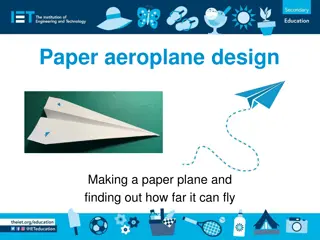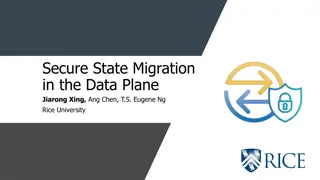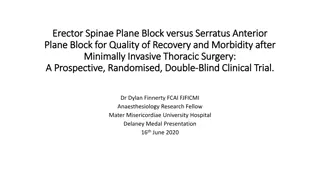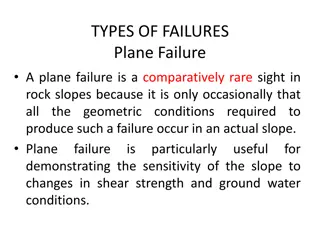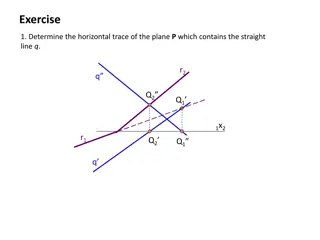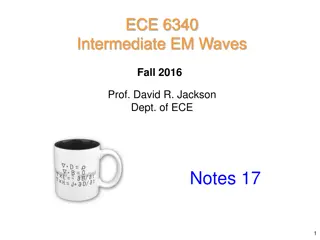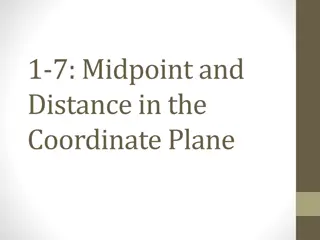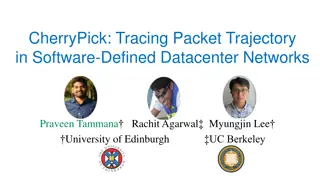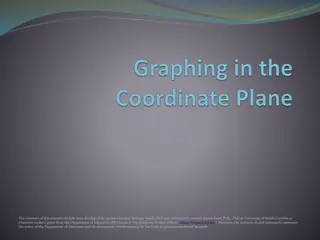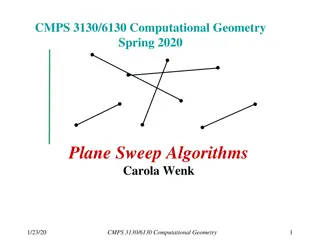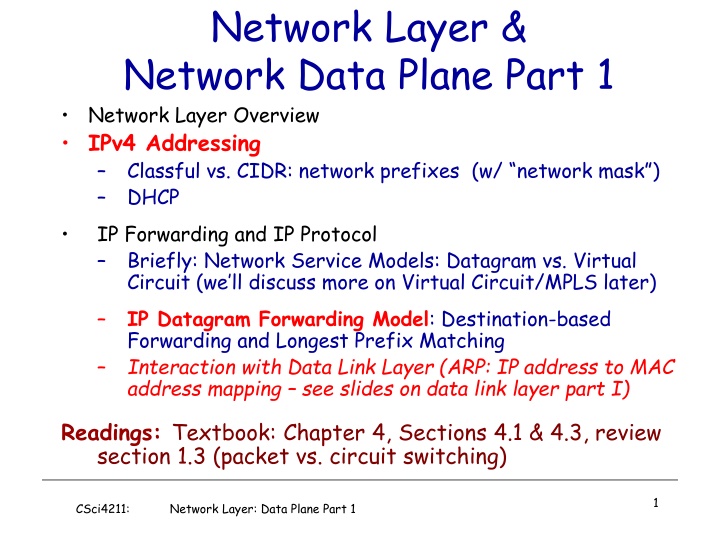
Network Layer Functions in Data Plane Part 1
Delve into the intricacies of the network layer, covering topics such as IPv4 addressing, DHCP, IP forwarding, network service models, and more. Explore how the network layer facilitates end-to-end packet delivery and the essential functions of addressing, routing, and forwarding. Gain insights into the comparison with other network layers and the significance of network-wide concerns.
Download Presentation

Please find below an Image/Link to download the presentation.
The content on the website is provided AS IS for your information and personal use only. It may not be sold, licensed, or shared on other websites without obtaining consent from the author. If you encounter any issues during the download, it is possible that the publisher has removed the file from their server.
You are allowed to download the files provided on this website for personal or commercial use, subject to the condition that they are used lawfully. All files are the property of their respective owners.
The content on the website is provided AS IS for your information and personal use only. It may not be sold, licensed, or shared on other websites without obtaining consent from the author.
E N D
Presentation Transcript
Network Layer & Network Data Plane Part 1 Network Layer Overview IPv4 Addressing Classful vs. CIDR: network prefixes (w/ network mask ) DHCP IP Forwarding and IP Protocol Briefly: Network Service Models: Datagram vs. Virtual Circuit (we ll discuss more on Virtual Circuit/MPLS later) IP Datagram Forwarding Model: Destination-based Forwarding and Longest Prefix Matching Interaction with Data Link Layer (ARP: IP address to MAC address mapping see slides on data link layer part I) Readings: Textbook: Chapter 4, Sections 4.1 & 4.3, review section 1.3 (packet vs. circuit switching) 1 CSci4211: Network Layer: Data Plane Part 1
What Does Network Layer Do? End-to-end deliver packet from sending to receiving hosts, hop-by- hop thru network A network-wide concern! Involves every router, host in the network Compare: Transport layer between two end hosts Data link layer over a physical link directly connecting two (or more) physically hosts application transport network data link physical network data link physical network data link physical network data link physical network data link physical network data link physical network data link physical network data link physical network data link physical application transport network data link physical 2 CSci4211: Network Layer: Data Plane Part 1
What Does Network Layer Do? transport segment from sending to receiving host on sending side encapsulates segments into datagrams on rcving side, delivers segments to transport layer network layer protocols in every host, router Router examines header fields in all IP datagrams passing through it application transport network data link physical network data link physical network data link physical network data link physical network data link physical network data link physical network data link physical network data link physical network data link physical application transport network data link physical 3 CSci4211: Network Layer: Data Plane Part 1
Network Layer Functions Addressing Globally unique address for each routable device Logical address, unlike MAC address (as you ll see later) Assigned by network operator Need to map to MAC address (as you ll see later) Routing: building a map of network Which path to use to forward packets from src to dest Forwarding: delivery of packets hop by hop From input port to appropriate output port in a router Routing and forwarding depend on network service models: datagram vs. virtual circuit 4 CSci4211: Network Layer: Data Plane Part 1
Two Key Network-Layer Functions forwarding: move packets from router s input to appropriate router output analogy: routing: process of planning trip from source to dest routing: determine route taken by packets from source to dest. forwarding: process of getting through single interchange routing algorithms 5 CSci4211: Network Layer: Data Plane Part 1
Network Layer: Data Plane, Control Plane Control plane network-wide logic determines how datagram is routed among routers along end-end path from source host to destination host two control-plane approaches: traditional routing algorithms: implemented in routers software-defined networking (SDN): implemented in (remote) servers Data plane local, per-router function determines how datagram arriving on router input port is forwarded to router output port forwarding function values in arriving packet header 1 0111 2 3 6 CSci4211: Network Layer: Data Plane Part 1
Per-router Control Plane Individual routing algorithm components in each and every router interact in the control plane Routing Algorithm control plane data plane values in arriving packet header 1 0111 2 3 7 CSci4211: Network Layer: Data Plane Part 1
Logically Centralized Control Plane A distinct (typically remote) controller interacts with local control agents (CAs) Remote Controller control plane data plane CA CA CA CA CA values in arriving packet header 1 0111 2 3 8 CSci4211: Network Layer: Data Plane Part 1
Routing & Forwarding: Logical View of a Router 5 3 B C 5 2 A 2 1 F 3 1 2 D E 1 9 CSci4211: Network Layer: Data Plane Part 1
Network Layer Functions Addressing Globally unique address for each routable device Logical address, unlike MAC address (as you ll see later) Assigned by network operator Need to map to MAC address (as you ll see later) IPv4 Addressing Routing: building a map of network Which path to use to forward packets from src to dest Forwarding: delivery of packets hop by hop From input port to appropriate output port in a router 10 CSci4211: Network Layer: Data Plane Part 1
IPv4 Addressing: Basics Globally unique (for public IP addresses) IPv4 address: 32-bit identifier for host, router interface Interface: connection between host/router and physical link router s typically have multiple interfaces host may have multiple interfaces IP addresses associated with each interface Dot notation (for ease of human reading) 223.1.1.1 = 11011111 00000001 00000001 00000001 223 1 1 1 11 CSci4211: Network Layer: Data Plane Part 1
IP Addressing: Network vs. Host 223.1.1.2 Two-level hierarchy network part (high order bits) host part (low order bits) What s a network ? (from IP address perspective) device interfaces with same network part of IP address can physically reach each other without intervening router 223.1.1.1 223.1.1.4 223.1.1.3 223.1.7.0 223.1.9.2 223.1.9.1 223.1.7.1 223.1.8.1 223.1.8.0 223.1.2.6 223.1.3.27 223.1.2.1 223.1.2.2 223.1.3.1 223.1.3.2 12 CSci4211: Network Layer: Data Plane Part 1
Classful IP Addressing class 7 15 23 31 1.0.0.0 to 127.255.255.255 128.0.0.0 to 191.255.255.255 192.0.0.0 to 223.255.255.255 A 0network host B network 10 host C network host 110 224.0.0.0 to 239.255.255.255 D multicast address 1110 32 bits Disadvantage: inefficient use of address space, address space exhaustion e.g., class B net allocated enough addresses for 65K hosts, even if only 2K hosts in that network 13 CSci4211: Network Layer: Data Plane Part 1
Classless Addressing: CIDR CIDR: Classless InterDomain Routing Network portion of address is of arbitrary length Addresses allocated in contiguous blocks Number of addresses assigned always power of 2 Address format: a.b.c.d/x x is number of bits in network portion of address host part network part 11001000 00010111 00010000 00000000 200.23.16.0/23 14 CSci4211: Network Layer: Data Plane Part 1
Special IP Addresses Network address: host id = all 0 s Directed broadcast address: host id = all 1 s Local broadcast address: all 1 s Local host address (this computer): all 0 s Loopback address network id = 127, any host id (e.g. 127.0.0.1) 15 CSci4211: Network Layer: Data Plane Part 1
IP Addresses: How to Get One? Q: How does host get IP address? static assigned: i.e., hard-coded in a file Wintel: control-panel->network->configuration->tcp/ip- >properties UNIX: /etc/rc.config Dynamically assigned: using DHCP (Dynamic Host Configuration Protocol) dynamically get address from as server plug-and-play 16 CSci4211: Network Layer: Data Plane Part 1
DHCP: Dynamic Host Configuration Protocol Goal: allow host to dynamically obtain its IP address from network server when it joins network Can renew its lease on address in use Allows reuse of addresses (only hold address while connected an on Support for mobile users who want to join network (more shortly) DHCP overview: host broadcasts DHCP discover msg DHCP server responds with DHCP offer msg host requests IP address: DHCP request msg DHCP server sends address: DHCP ack msg 17 CSci4211: Network Layer: Data Plane Part 1
DHCP Client-Server Scenario A 223.1.2.1 DHCP server 223.1.1.1 223.1.1.2 223.1.2.9 223.1.1.4 B arriving DHCP client needs address in this network 223.1.2.2 E 223.1.1.3 223.1.3.27 223.1.3.2 223.1.3.1 18 CSci4211: Network Layer: Data Plane Part 1
DHCP Client-Server Scenario DHCP server: 223.1.2.5 DHCP discover arriving client src : 0.0.0.0, 68 dest.: 255.255.255.255,67 yiaddr: 0.0.0.0 transaction ID: 654 DHCP offer src: 223.1.2.5, 67 dest: 255.255.255.255, 68 yiaddrr: 223.1.2.4 transaction ID: 654 Lifetime: 3600 secs DHCP request src: 0.0.0.0, 68 dest:: 255.255.255.255, 67 yiaddrr: 223.1.2.4 transaction ID: 655 Lifetime: 3600 secs time DHCP ACK src: 223.1.2.5, 67 dest: 255.255.255.255, 68 yiaddrr: 223.1.2.4 transaction ID: 655 Lifetime: 3600 secs 19 CSci4211: Network Layer: Data Plane Part 1
DHCP: More Than IP Addresses DHCP can return more than just allocated IP address on subnet: address of first-hop router for client name and IP address of DNS sever network mask (indicating network versus host portion of address) 20 CSci4211: Network Layer: Data Plane Part 1
IP Addresses: How to Get One? Q: How does network get network part of IP addr? A: gets allocated portion of its provider ISP s address space ISP's block 11001000 00010111 00010000 00000000 200.23.16.0/20 Organization 0 11001000 00010111 00010000 00000000 200.23.16.0/23 Organization 1 11001000 00010111 00010010 00000000 200.23.18.0/23 Organization 2 11001000 00010111 00010100 00000000 200.23.20.0/23 ... .. . . Organization 7 11001000 00010111 00011110 00000000 200.23.30.0/23 21 CSci4211: Network Layer: Data Plane Part 1
IP Addressing: the Last Word... Q: How does an ISP get block of addresses? A:ICANN: Internet Corporation for Assigned Names and Numbers allocates addresses manages DNS assigns domain names, resolves disputes 22 CSci4211: Network Layer: Data Plane Part 1
Recall: Network Layer Functions Addressing Globally unique address for each routable device logical address, unlike MAC address (as you ll see later) Assigned by network operator Need to map to MAC address (as you ll see later) Routing: building a map of network Which path to use to forward packets from src to dest IPv4 Addressing Forwarding: delivery of packets hop by hop from input port to an appropriate output port in a router (more on how this is done later!) How forwarding is done depending on the network service models : e.g., datagram vs. virtual circuit We ll look at IP datagram forwarding model shortly afterwards! 23 CSci4211: Network Layer: Data Plane Part 1
Network Service Model Q: What service model for channel transporting packets from sender to receiver? guaranteed bandwidth? preservation of inter-packet timing (no jitter)? loss-free delivery? in-order delivery? congestion feedback to sender? The most important abstraction provided by network layer: ?? ? virtual circuit or datagram? 24 CSci4211: Network Layer: Data Plane Part 1
Network Service Model (contd) Some Possible Examples: Example services for individual datagrams: guaranteed delivery guaranteed delivery with less than 40 msec delay Example services for a flow of datagrams: in-order datagram delivery guaranteed minimum bandwidth to flow restrictions on changes in inter- packet spacing 25 CSci4211: Network Layer: Data Plane Part 1
Network Layer Connection vs. Connectionless Service datagram network provides network-layer connectionless service VC network provides network-layer connection service analogous to the transport-layer services, but: service: host-to-host generally no choice: network typically provides one or the other implementation: in network core network vs transport layer connection service: network: between two hosts, in case of VCs, also involves intervening routers transport: between two processes 26 CSci4211: Network Layer: Data Plane Part 1
Virtual Circuit vs. Datagram Objective of both: move packets through routers from source to destination Datagram Model: Routing: determine next hop to each destination a priori Forwarding: destination address in packet header, used at each hop to look up for next hop routes may change during session analogy: driving, asking directions at every gas station, or based on the road signs at every turn Virtual Circuit Model: Routing: determine a path from source to each destination Call Set-up: fixed path ( virtual circuit ) set up at call setup time, remains fixed thru call Data Forwarding: each packet carries tag or label (virtual circuit id, VCI), which determines next hop routers maintain per-call state 27 CSci4211: Network Layer: Data Plane Part 1
Datagram Networks: the Internet model no call setup at network layer routers: no state about end-to-end connections no network-level concept of connection packets forwarded using destination host address packets between same source-dest pair may take different paths, when intermediate routes change! application transport network data link physical application transport network data link physical 1. Send data 2. Receive data 28 CSci4211: Network Layer: Data Plane Part 1
Interplay Between Routing and Forwarding routing algorithm local forwarding table header value output link 0100 0101 0111 1001 3 2 2 1 value in arriving packet s header 1 0111 2 3 29 CSci4211: Network Layer: Data Plane Part 1 CSci4211: Network Layer: Data Plane Part 1
Forwarding Table 4 billion possible entries Destination Address Range Link Interface 11001000 00010111 00010000 00000000 through 0 11001000 00010111 00010111 11111111 11001000 00010111 00011000 00000000 through 1 11001000 00010111 00011000 11111111 11001000 00010111 00011001 00000000 through 2 11001000 00010111 00011111 11111111 otherwise 3 30 CSci4211: Network Layer: Data Plane Part 1
IP Forwarding Table 4 billion possible entries! (in reality, far less, but can still have millions of routes ) forwarding table entry format destination network (1st IP address , network mask ) 11001000 00010111 00010000 00000000, 11111111 11111111 11111000 00000000 next-hop (IP address) link interface 200.23.16.1 0 11001000 00010111 00011000 00000000, - (direct) 1 11111111 11111111 11111111 00000000 11001000 00010111 00011001 00000000, 200.23.25.6 2 11111111 11111111 11111000 00000000 otherwise 128.30.0.1 3 31 CSci4211: Network Layer: Data Plane Part 1
Route aggregation: Shrinking the forwarding table Organization 0 Send me anything with addresses beginning 200.23.0.0/20 200.23.2.0/23 Port 0 Organization 1 200.23.4.0/23 Organization 2 UMN ... 200.23.6.0/23 ... Internet Port 1 CSE Department Port 7 200.23.14.0/23 32 CSci4211: Network Layer: Data Plane Part 1
Route aggregation with more specific routes UMN-FAST has a more specific route to CSE department Organization 0 Send me anything with addresses beginning 200.23.0.0/20 200.23.2.0/23 Organization 2 UMN ... 200.23.4.0/23 ... Internet CSE Department 200.23.14.0/23 Send me anything with addresses beginning 200.23.14.0/23 UMN-FAST 33 CSci4211: Network Layer: Data Plane Part 1
Longest Prefix Matching longest prefix matching when looking for forwarding table entry for given destination address, use longest address prefix that matches destination address. Link interface Prefix Match 0 11001000 00010111 00010*** ********* 1 11001000 00010111 00011000 ********* 2 11001000 00010111 00011*** ********* 3 otherwise Examples DA: 11001000 00010111 00010110 10100001 interface 0 interface 1 ! DA: 11001000 00010111 00011000 10101010 But not interface 2, the 3rd entry is also a match, but shorter! 34 CSci4211: Network Layer: Data Plane Part 1
IP Datagram Forwarding Model forwarding table in A Dest. Net. next router Nhops 223.1.1 1 223.1.2 223.1.1.4 2 223.1.3 223.1.1.4 2 IP datagram: source IP addr misc fields dest IP addr data A 223.1.1.1 datagram remains unchanged, as it travels source to destination addr fields of interest here 223.1.2.1 223.1.1.2 223.1.2.9 223.1.1.4 B 223.1.2.2 E 223.1.1.3 223.1.3.27 223.1.3.2 223.1.3.1 35 CSci4211: Network Layer: Data Plane Part 1
IP Forwarding: Destination in Same Net forwarding table in A Dest. Net. next router Nhops 223.1.1 1 223.1.2 223.1.1.4 2 223.1.3 223.1.1.4 2 misc fields223.1.1.1 223.1.1.3 data Starting at A, send IP datagram addressed to B: look up net. address of B in forwarding table find B is on same net. as A link layer will send datagram directly to B inside link-layer frame B and A are directly connected A 223.1.1.1 223.1.2.1 223.1.1.2 223.1.2.9 223.1.1.4 B 223.1.2.2 E 223.1.1.3 223.1.3.27 223.1.3.2 223.1.3.1 36 CSci4211: Network Layer: Data Plane Part 1
IP Forwarding: Destination in Diff. Net misc fields223.1.1.1 223.1.2.3 data forwarding table in A Dest. Net. next router Nhops 223.1.1 1 223.1.2 223.1.1.4 2 223.1.3 223.1.1.4 2 Starting at A, dest. E: look up network address of E in forwarding table E on different network A, E not directly attached routing table: next hop router to E is 223.1.1.4 link layer sends datagram to router 223.1.1.4 inside link- layer frame datagram arrives at 223.1.1.4 continued .. A 223.1.1.1 223.1.2.1 223.1.1.2 223.1.2.9 223.1.1.4 B 223.1.2.2 E 223.1.1.3 223.1.3.27 223.1.3.2 223.1.3.1 37 CSci4211: Network Layer: Data Plane Part 1
IP Forwarding: Destination in Diff. Net forwarding table in router misc fields223.1.1.1 223.1.2.3 data Dest. Net router Nhops interface 223.1.1 - 1 223.1.1.4 223.1.2 - 1 223.1.2.9 223.1.3 - 1 223.1.3.27 Arriving at 223.1.4, destined for 223.1.2.2 look up network address of E in router s forwarding table E on same network as router s interface 223.1.2.9 router, E directly attached link layer sends datagram to 223.1.2.2 inside link-layer frame via interface 223.1.2.9 datagram arrives at 223.1.2.2!!! (hooray!) A 223.1.1.1 223.1.2.1 223.1.1.2 223.1.2.9 223.1.1.4 B 223.1.2.2 E 223.1.1.3 223.1.3.27 223.1.3.2 223.1.3.1 38 CSci4211: Network Layer: Data Plane Part 1
IP Forwarding & IP/ICMP Protocol Transport layer: TCP, UDP IP protocol addressing conventions Datagram format packet handling conventions Routing protocols path selection RIP, OSPF, BGP Network layer forwarding table ICMP protocol error reporting router signaling Data Link layer (Ethernet, WiFi, PPP, ) Physical Layer (SONET, ) 39 CSci4211: Network Layer: Data Plane Part 1
IP Datagram Format 32 bits IP protocol version total datagram length (bytes) number header length (bytes) type of data type of service head. len ver length fragment offset flgs 16-bit identifier time to live 32 bit source IP address 32 bit destination IP address max number remaining hops (decremented at each router) upper layer protocol to deliver payload to upper layer Internet checksum E.g. timestamp, record route taken, specify list of routers to visit. Options (if any) data how much overhead with TCP? 20 bytes of TCP 20 bytes of IP = 40 bytes + app layeroverhead (variable length, typically a TCP or UDP segment) 40 CSci4211: Network Layer: Data Plane Part 1
Fields in IP Datagram IP protocol version: current version is 4, IPv4, new: IPv6 Header length: number of 32-bit words in the header Type of Service: 3-bit priority,e.g, delay, throughput, reliability bits, Total length: including header (maximum 65535 bytes) Identification: all fragments of a packet have same identification Flags: don t fragment, more fragments Fragment offset: where in the original packet (count in 8 byte units) Time to live: maximum life time of a packet Protocol Type: e.g., ICMP, TCP, UDP etc IP Option: non-default processing, e.g., IP source routing option, etc. Will come back to discuss more about some of these headers! 41 CSci4211: Network Layer: Data Plane Part 1
Interaction w/ Data Link Layer We now take a detour from the network layer and dive into the data link layer now, so that we can understand how IP datagrams within the same IP subnet are actually delivered directly by the data link layer (which uses only MAC addresses for forwarding!), see the data link layer part 1 slides We ll provide a quick overview of data link layer We will learn about MAC addresses How IP addresses are mapped to MAC addresses via the ARP protocol How layer-2 switches (e.g., Ethernet switches or bridges ) learn and build switch tables and forward packets ! 42 CSci4211: Network Layer: Data Plane Part 1


